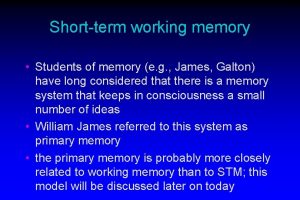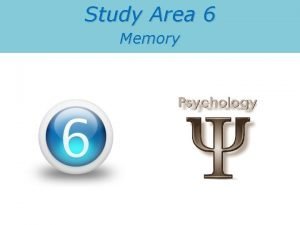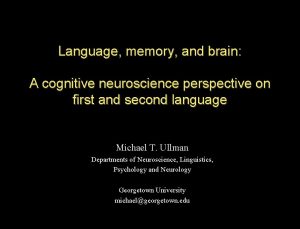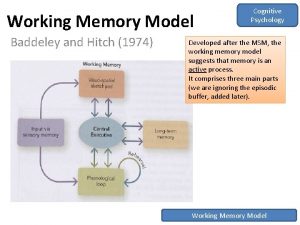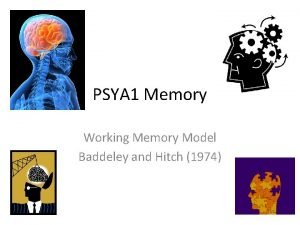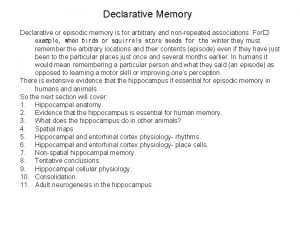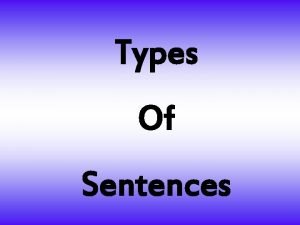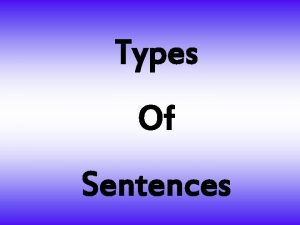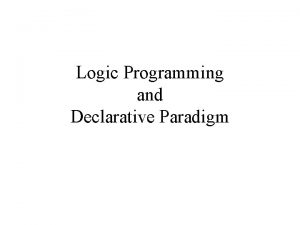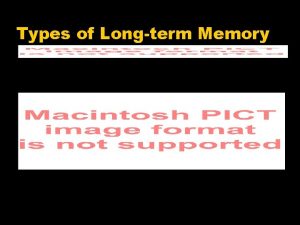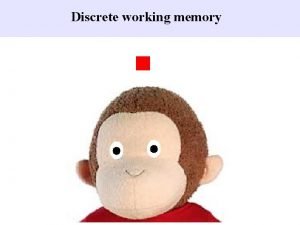Review Systems of Memory Declarative Memory Working memory












- Slides: 12

Review: Systems of Memory • Declarative Memory • Working memory • Episodic memory • Semantic memory • Nondeclarative Memory • Priming • Conditioning • Motor/Procedural memory

Declarative Memory • AKA “explicit memory” • Controlled consciously and intentionally, involves some level of effort. • Mediated by hippocampus and frontal lobes • Generally declines with age • Some examples: • recalling the name of an old friend • remembering a list of items to pick up at the store • remembering information for a test • remembering your student ID number

Declarative Memory Subsystems • Working Memory • Lasts anywhere from 2 to 18 seconds • Short term system that allows us to store and use pieces of information quickly • Used for mental calculations (like figuring out a tip), retaining information briefly (like dialing a phone number), and processing information (like listening to a newscast). • Also allows us to temporarily process information we have previously learned and access it to learn and attach new information.

Declarative Memory Subsystems • Episodic Memory • Long-term memory system storing events (or “episodes”) of one’s own life • used to recall past events, such as a movie you saw last week, the dinner you ate last night, the name of the book your friend recommended, or a birthday party you attended • Semantic Memory • a long-term memory system that stores general knowledge. • Examples of what semantic memory stores are vocabulary or facts such as 2+2 = 4 and Michigan is a state in the United States.

Nondeclarative Memory • • AKA “implicit memory” Influences us without us being aware of it Operates unconsciously and unintentionally, involves no effort. mediated by cortical areas, the cerebellum, and the basal ganglia. • remains relatively stable with normal aging. • Some examples: • riding a bike • using the same verbal patterns as friends (e. g. , saying “like” repeatedly) • classical conditioning.

Nondeclarative Memory Subsystems • Priming is an automatic or unconscious process that can improve the speed and accuracy of a response because of past experience. • Different cues prompt the retrieval of memory. • Priming helps trigger associated concepts or memories, making the retrieval process more efficient. • An example of priming is repetition priming: You are faster reading the word “pretzel” aloud when you have just recently read it. • Another example is semantic priming: You are faster and more likely to say the word “nurse” when you have just recently read the word “doctor. ”

Nondeclarative Memory Subsystems • Procedural/Motor memory is the memory for the process involved in completing a task (e. g. , motor memory) after the task is well learned and has become automatic. (Basically, any ingrained skill) • Examples include playing the piano, typing, hitting a tennis ball • Classical conditioning is memory for associations formed between two stimuli. • An example of classical conditioning is Pavlov’s classic experiment with dogs: Just before presenting a dog with food, the researcher rang a bell. Soon, the animal learned the bell indicated food was imminent and would salivate at the sound of the bell. (Humans can also become conditioned to the sound of a ring tone consistently paired with a specific caller. )

Sensory Register • The sensory register is a memory system that works for a very brief period of time that stores a record of information received by receptor cells until the information is selected for further processing or discarded. • The sensory memory register is specific to individual senses: • Iconic memory for visual information, echoic memory for auditory information • Duration is very brief: • 150 -500 msec for visual information • 1 -2 sec for auditory information

Sensory Register • The capacity of the sensory register is believed to be large. • Information in store is meaningless unless it is selected for further processing by being attended to in an effortful way. • The general purpose of the sensory information stores seems to be to keep information around, albeit briefly, for further processing. Processing information takes time.

Sensory Register vs. Working Memory • Working memory (WM) is a short-term memory system we use to store and process information we are currently thinking about. • Capacity of sensory memory is large (e. g. , everything in your visual field is stored in iconic memory, or everything that is sufficiently loud is stored in echoic memory), the capacity of WM is much smaller. • Typically, some of the information in iconic memory is selected for further processing in WM. • Sensory memory operates preattentively (unconsciously), Working Memory is par of consciousness. • It operates like a sketchpad or desktop in the sense that it allows a person to comprehend, retrieve, and manipulate information.

Links • TED talk Video: http: //www. ted. com/talks/peter_doolittle_how_you r_working_memory_makes_sense_of_the_world • Operation Span Task: http: //www. millisecond. com/download/library/v 4/O SPAN/Automated. OSPAN. web

Characteristics of working memory • Storage capacity of working memory is small: around 7 plus or minus 2 items. • Zip codes, phone numbers, and most passwords are consistent with 7+/-2 items. • Duration of working memory is limited (about 2 -18 seconds). • When people cannot rehearse (practice), information dissipates from working memory in about 18 seconds. • Information is typically encoded acoustically (by sound) in working memory. • It is more difficult to remember items that sound alike (e. g. , T, C, B, V, E) than items that do not sound alike (e. g. , T, L, X).
 Slave systems working memory model
Slave systems working memory model Which memory is the actual working memory?
Which memory is the actual working memory? Implicit memory
Implicit memory Declarative memory
Declarative memory Smart work vs hard work
Smart work vs hard work Hot working metal
Hot working metal Hot working and cold working difference
Hot working and cold working difference Differentiate between hot working and cold working
Differentiate between hot working and cold working Pembentukan plat pada pengerjaan panas
Pembentukan plat pada pengerjaan panas Payment systems and working hours
Payment systems and working hours What is a working model psychology
What is a working model psychology Working memory model
Working memory model Automated working memory assessment (awma)
Automated working memory assessment (awma)
